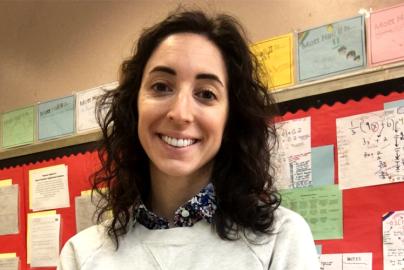
By MƒA Master Teacher Michele Stassfurth
For the past three school years, teachers in all New York City public schools have been given the results of student perception surveys. These surveys ask students to answer questions falling under the umbrella of five major categories: students respond about instruction and classroom experiences for a specific teacher, and then these results are shared with the pedagogue. As a mathematics teacher, I love quantitative feedback, and though I am always curious to see all the results, I head first to view those in the category of Teacher-Student Relationships.
In my first and second years of teaching, I was focused on making sure I had control of my classroom and that I was successfully teaching standards-grounded content. Now in my seventh year of teaching, I can tell you that the most important component is not connected to any standard, but it is knowing and caring about your students. As a student teacher before my career began, a supervisor showed us the quote, often attributed to John C. Maxwell: “Students don’t care how much you know until they know how much you care.” In my opinion, this is the most important tenet of teaching.
In almost any classroom, when thirty students walk through your classroom door, you are met with thirty different backstories, temperaments, and learning styles. Some of these students may be inherently interested in learning and some may not: showing students you care is the gateway to flipping that imbalance.
Students want to be heard and not just spoken to; they want to know that the teacher in front of them genuinely cares about their well-being and understands them as humans.
As Zaretta Hammond states in her text “Culturally Responsive Teaching & the Brain,” teachers must work to foster learning partnerships, and should do this through developing a positive rapport and by actively caring for students.
The first step to successful teaching is having the respect of the students, which comes from them feeling respected by their teacher. At the advice of my Math for America advisor years ago, I started asking students to write a journal entry once or twice a year to express their feelings about math class, school, and their lives in general. I have always written replies to every single student. From this, I have learned so much valuable information, from students needing seat changes who were too quiet to ask otherwise to students with very difficult situations occurring outside of school who needed my empathy and support. Acknowledging student needs makes them feel valued, supported, and respected. It creates buy-in from the students, which, in turn, makes them more willing to listen and to learn, and, often, results in better student behavior.
There are myriad teaching strategies to engage students in learning content in our classrooms. However, I assert that these will be ineffective unless the students feel valued and respected and that they also respect their teacher. Something as simple as asking students if they want the classroom windows opened or closed or if they want a one-minute mental break in the middle of the lesson because they’ve had a tough day can greatly improve classroom culture and comfort, which can lead to greater student outcomes in all regards.
Another way to show students you care is to acknowledge students’ birthdays: by writing each student’s birthday on a visible wall calendar in my classroom, I am always aware of a student’s special day. Being wished a happy birthday by teachers and peers and to be honored for a day makes learners feel like valued members of the classroom community. I also have a dedicated bulletin board in my room that I have designated as a “Proud Board:” here, students can write down anything of which they are proud, and it has been yet another way to give students the space to share information about themselves and to feel valued and acknowledged. Additionally, all eighth-grade teachers at my school have started classroom mailboxes where students can drop a note any day if they have something to say or ask and prefer to do so in writing.
Finally, a critical element in showing students you care is knowing when they need support: sometimes, allowing a student in distress to take a break and draw a picture or shut their eyes for a moment during a lesson allows them to regroup and feel understood, which often brings them back more prepared to learn than if they had been reprimanded or ignored.
To care about your students is not to neglect knowledge of content and knowledge of pedagogy, but it is an extremely significant aspect to fostering a successful classroom environment and healthy rapport with young learners. Only when students know you care will they care at all that you know the content. As the late Dr. Rita Pierson states in her famous TED talk, “the value and importance of human connection” is not discussed often enough in education and this idea of a respectful relationship between teachers and learners is a critical component to students’ learning.
In the student perception survey, there is a question that asks students “When your teacher asks how you are doing, how often do you feel that your teacher is really interested in your answer?” We should all strive to ensure that students can honestly answer this question favorably.
All teachers have a responsibility to understand and care about their students, and by taking an interest in their lives and well-being, teaching will be much more effective and rewarding in return.
